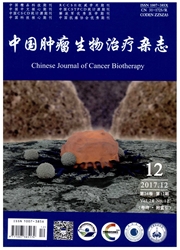

 中文摘要:
中文摘要:
目的:探讨碳纳米管(CNT)-树形分子递送Survivin反义寡核苷酸(ASOND)进入肝癌细胞HepG2的效率及其对肝癌细胞增殖的影响。方法:制备碳纳米管与PAMAM树形分子复合物,与Survivin反义寡核苷酸组装后,用原子力显微镜(AFM)与凝胶电泳观察碳纳米管-树形分子-反义核苷酸复合物的形态结构;然后将复合物与人肝癌HepG2细胞共培养,同时设立对照,采用透射电镜观察碳纳米管-树形分子-反义核苷酸复合物在细胞中的定位,采用MTT法检测复合物对癌细胞生长的抑制作用。结果:AFM与凝胶电泳分析证实碳纳米管-树形分子-反义核苷酸复合物被成功制备。透射电镜观察证实碳纳米管-树形分子-反义核苷酸复合物位于细胞质。MTT法检测表明,CNT-PAMAM-ASODN浓度为1.0 μmol/L时,即可抑制(45.97±4.28)%的HepG2细胞增殖,而ASODN组和CNT-PAMAM组在此浓度条件下对HepG2细胞的抑制率则分别为(9.33±0.85)%和(6.37±0.69)%;当CNT-PAMAM-ASODN达到1.50 μmol/L时,细胞抑制率为(70.22±7.25)%,而且抑制作用随培养时间的延长与浓度的增加而增强,实验组与对照组之间细胞抑制率存在显著性差异(P<0.01)。结论:碳纳米管一树形分子复合物是一种高效的基因递送载体,能够携带Survivin反义寡核苷酸进入肝癌细胞,并高效抑制HepG2细胞的增殖,显著增强反义寡核苷酸的作用效果。
 英文摘要:
英文摘要:
Objective: To investigate the efficiency of carbon nanotube(CNT) -PAMAM mediated entrance of anti-survivin oligonucleotide into HepG2 cells, and its effects on the proliferation of HepG2 cells. Methods: CNT-PAMAM-antisurvivin oligonucleotide compounds were prepared and characterized by AFM and 1% agarose gel electrophoresis analysis. TEM was used to observe the distribution of CNT-PAMAM-ASODN compounds in HepG2 cells. CNT-PAMAM-ASODN compounds were added into the medium and co-cultured with HepG2 cells for 24 h, 48 h,72 h, and 96 h at 37℃, 5% CO2. MTT method was used to detect the effects of ASODN and CNT-PAMAM-ASODN on the proliferation of HepG2 cells. Results: CNT-PAMAM-ASODN compounds were successfully synthesized via AFM and agarose gel electrophoresis. TEM showed that the compounds were located in the cytoplasm. When CNT-PAMAM-ASODN ( 1.0 μmol/L) and ASODN (1.0 μmol/L) were used for a 48 h culture, the inhibitory rates of HepG2 cells were (45.97 ±4.28 ) % for CNT-PAMAM-ASODN compounds group, (9.33 ± 0.85 ) % for ASODN group, and ( 6.37 ± 0.69) % for CNT-PAMAM group. CNT-PAMAM-ASODN compounds at 1.5 μmol/L inhibited HepG2 cells by (70.22 ± 7.25 ) %, and the inhibitory effects were in a time- and concentration-dependent manner. There was statistical difference between experiment group and control group ( P 〈 0.01 ). Conclusion : CNT-PAMAM compounds may serve as a gene delivery vector with high efficiency, which can bring survivin ASODN into HepG2 cells, inhibiting HepG2 cell proliferation and markedly enhancing the inhibitory effects of survivin against HepG2 cells.
 同期刊论文项目
同期刊论文项目
 同项目期刊论文
同项目期刊论文
 期刊信息
期刊信息
